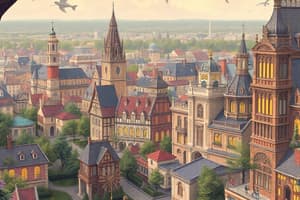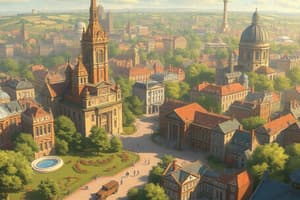Podcast
Questions and Answers
Which urban planner founded the English Garden City Movement?
Which urban planner founded the English Garden City Movement?
- Angeline Guarino
- Roanne Jose
- Ebenezer Howard (correct)
- Bjay Orapa
What is a common characteristic of planned communities?
What is a common characteristic of planned communities?
- They are located in remote areas
- They are densely populated
- They have been carefully planned from their inception (correct)
- They lack proper urban planning
What did the concept of Garden Cities of To-morrow aim at?
What did the concept of Garden Cities of To-morrow aim at?
- Expanding urban problems in industrial cities
- Building industrial cities with advanced technology
- Creating a utopian city harmonious with nature (correct)
- Establishing self-contained towns with no greenbelts
What were the 3 magnets of the Garden City Movement?
What were the 3 magnets of the Garden City Movement?
What are the main components of the Garden City concept?
What are the main components of the Garden City concept?
Study Notes
Urban Planning Movements
- The English Garden City Movement was founded by Ebenezer Howard.
Characteristics of Planned Communities
- A common characteristic of planned communities is that they are designed to be self-contained and separate from the surrounding urban environment.
Garden Cities of To-morrow
- The concept of Garden Cities of To-morrow, developed by Ebenezer Howard, aimed at creating planned communities that would combine the benefits of town and country living.
The Garden City Movement
- The three magnets of the Garden City Movement were: Country, Town, and Town-Country, which represented the attraction of rural environments, urban amenities, and the ideal balance between the two, respectively.
Garden City Concept
- The main components of the Garden City concept include:
- A limited population size to prevent overcrowding
- A greenbelt of agricultural land surrounding the city to preserve nature and provide food
- A decentralized, radial city plan with multiple centers of activity
- A range of social services and community facilities
- A balance between residence, industry, and agriculture
Studying That Suits You
Use AI to generate personalized quizzes and flashcards to suit your learning preferences.
Description
Test your knowledge about planned communities and the influential Garden City Movement with this quiz. Explore the history, concepts, and examples of carefully planned towns and cities.





